Clearing ruins launches new phase in California fire cleanup
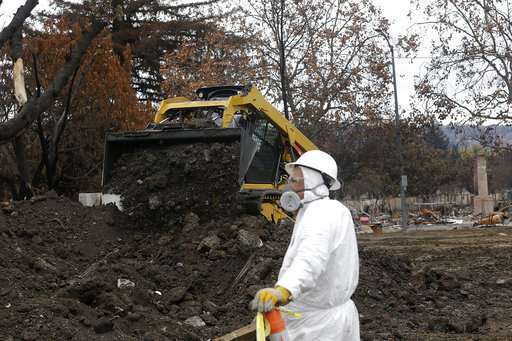
Rumbling bulldozers and front-loaders have started scraping up the ash, charred wood and crumbled bricks and concrete left from thousands of homes and buildings destroyed by blazes in California wine country, launching a new phase in the largest wildfire cleanup in state history.
U.S. Army Corps of Engineers contractors began the work this week in flattened, blackened blocks of Santa Rosa's Coffey Park neighborhood. It experienced some of the most-sweeping destruction last month when fierce winds drove flames that killed at least 43 people and destroyed 8,900 houses and other buildings across Northern California.
On Santa Rosa streets where hundreds of houses once stood, "you look across the landscape and see nothing but burned everything," Army Corps spokesman Rick Brown said as crews and heavy equipment around him began clearing debris from lots.
U.S., state and local agencies are working on the cleanup, which includes testing soil, air and water samples from burned areas for contamination. Authorities say they expect to have the lots cleared for property owners by early 2018, although rebuilding is expected to take years more.
California puts the insured losses at $3.3 billion so far, among the highest of any U.S. wildfires in recent decades.
In hard-hit Sonoma and Napa counties, the U.S. Environmental Protection Agency finished the first phase of cleanup at most properties: removing potential hazardous substances before the heavy equipment moves in.
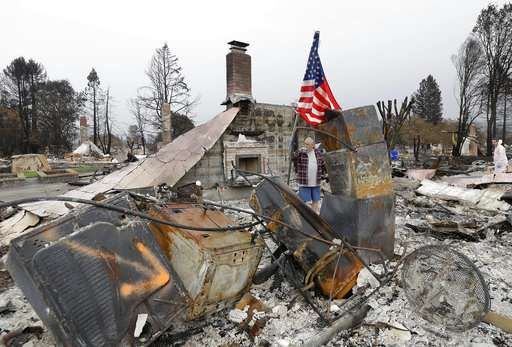
Generally, the fires overran housing developments and rural areas rather than industrial sites, so the hazardous waste is mainly what's in garages and barns—propane tanks from barbecue grills, cans of motor oil, and pesticides, officials say.
That contrasts with Hurricane Harvey, which flooded more than a dozen Superfund sites in Houston and other coastal areas this year, raising fears that contamination may have reached a wide area. The damage is still being assessed.
In California, crews have started scraping up home foundations and the top 3 to 6 inches (75 to 150 millimeters) of ash, debris and soil, said Brown of the Army Corps of Engineers. In some of the more upscale developments on ridgetops, the work is complicated by ruins that have tumbled downhill, he said.
The Army Corps is taking soil samples near burned homes and buildings and will take more from the lots after they have been scraped, Brown said. The state will test the samples for contaminants such as asbestos or other metals and chemicals to ensure the sites are clean enough for rebuilding.
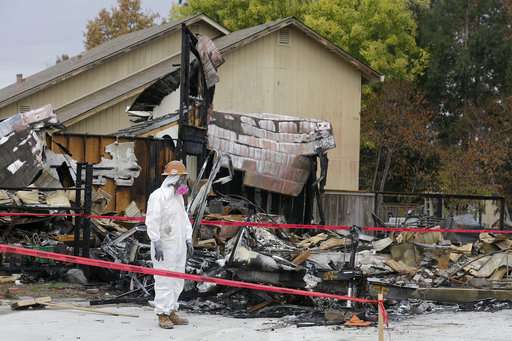
If not, "we'll scrape a couple more inches of soil, take that back to the lab, and let them decide if that does it," Brown said.
Some of those who lost homes have been confused over warnings of possible hazardous substances in the ruins of their neighborhoods. Watching the heavy equipment at work this week, survivor Larry Keyser admitted worrying over contamination but wasn't sure what the cleanup crews would be testing for.
"Like any concerned citizen, you want to be concerned about your environment," Keyser said.
Officials, meanwhile, have placed about a dozen air monitors around Sonoma County, including four at schools. The wildfires burned for more than a week and shrouded much of the San Francisco Bay Area in smoke, creating some of the worst air-quality readings on record there.
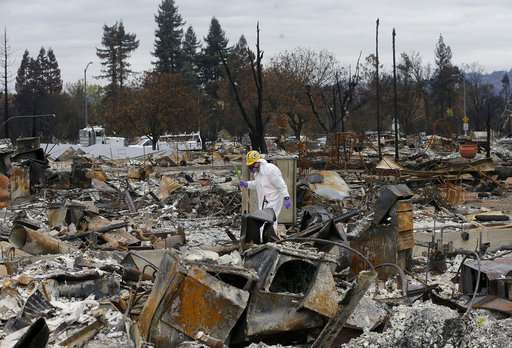
The air in the burned region is again testing at healthy levels, said Melanie Turner, spokeswoman at the California Air Resources Board.
Around the wildfire zones, teams from local water departments, the U.S. Geological Survey and Lawrence Berkeley National Laboratories also have been working to reduce and monitor any hazardous runoff into hundreds of waterways.
Teams have spent weeks positioning bundles of straw and bags of gravel or sand between blackened neighborhoods and creeks critical to people and native species, such as local coho salmon.
Devastated areas have received only light rain so far, but heavy downpours could sweep massive amounts of debris and contaminants into waterways.
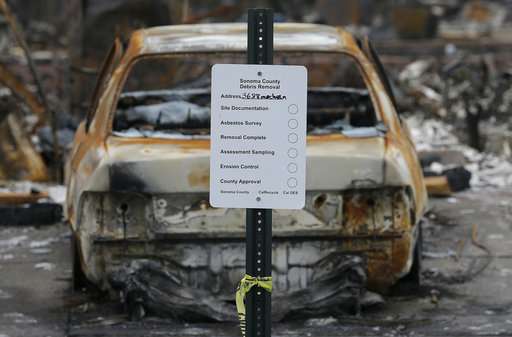
With more showers at midweek, Rich Fadness at the North Coast Regional Water Quality Control Board readied a dozen staffers to grab samples of runoff flowing into creeks at four key sites.
"Any time there's a fire, there's always issues," Fadness said. "With the amount of work we're doing, I hope it will be minimized."
-
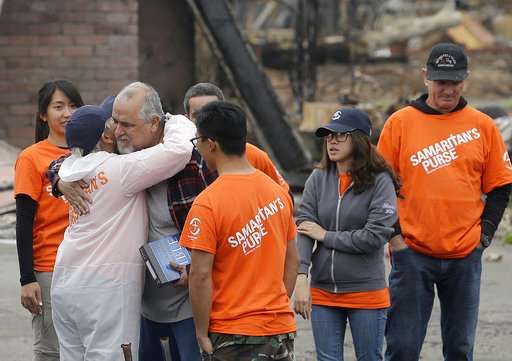
Larry Keyser, third from left, hugs volunteers from Samaritan's Purse disaster relief after they helped him sift through remains of his family's home destroyed by fires in the Coffey Park area of Santa Rosa, Calif., Wednesday, Nov. 8, 2017. Rumbling front loaders began scraping up the ash and rubble of nearly 9,000 destroyed homes and other structures in Northern California this week as the U.S. Army Corps of Engineers launched a new phase of the largest wildfire clean-up in the state's history. (AP Photo/Jeff Chiu) -
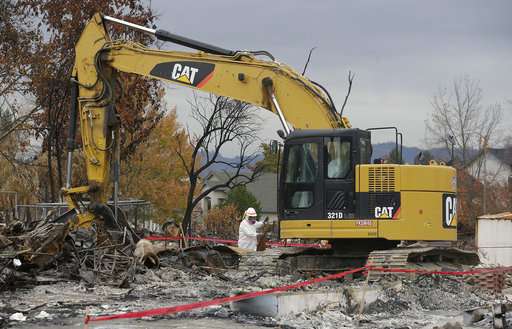
Work crews remove debris a the site of a home destroyed by fires in the Coffey Park area of Santa Rosa, Calif., Wednesday, Nov. 8, 2017. Rumbling front loaders began scraping up the ash and rubble of nearly 9,000 destroyed homes and other structures in Northern California this week as the U.S. Army Corps of Engineers launched a new phase of the largest wildfire clean-up in the state's history. (AP Photo/Jeff Chiu) -
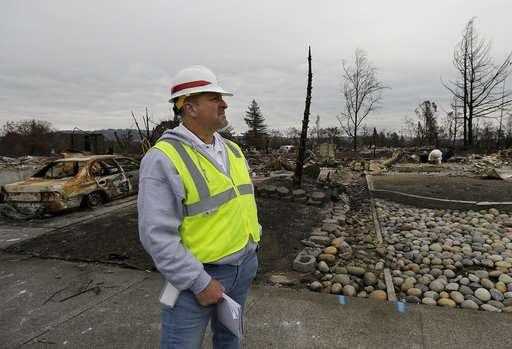
Rick Brown of the U.S. Army Corps of Engineers is interviewed as he watches work crews remove debris a the site of a home destroyed by fires in the Coffey Park area of Santa Rosa, Calif., Wednesday, Nov. 8, 2017. Rumbling front loaders began scraping up the ash and rubble of nearly 9,000 destroyed homes and other structures in Northern California this week as the U.S. Army Corps of Engineers launched a new phase of the largest wildfire clean-up in the state's history. (AP Photo/Jeff Chiu) -
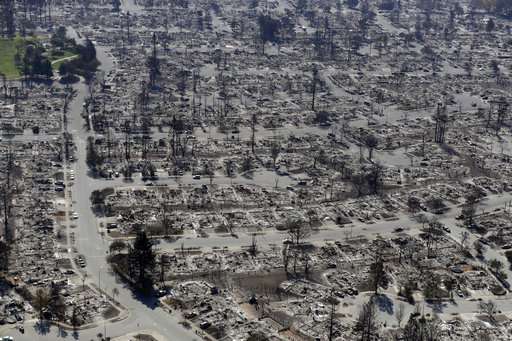
In this Oct. 14, 2017, file photo, an aerial view shows the devastation of the Coffey Park neighborhood after a wildfire swept through in Santa Rosa, Calif. Rumbling bulldozers have started scraping up the ash, charred wood and crumbled bricks left from thousands of homes and buildings destroyed by wildfires in California wine country. U.S. Army Corps of Engineers contractors began the work this week in flattened, blackened blocks of Santa Rosa's Coffey Park neighborhood. (AP Photo/Marcio Jose Sanchez, File)
© 2017 The Associated Press. All rights reserved.





















